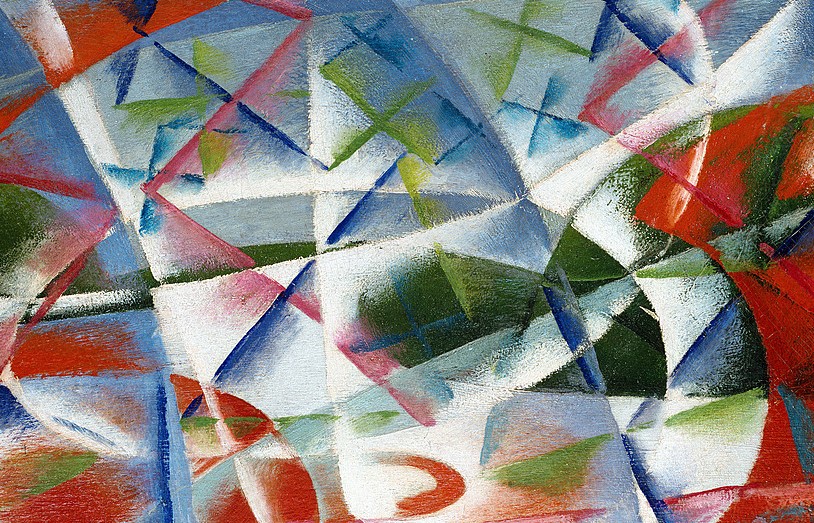Abstract Speed + Sound is a painting created by Giacomo Balla in 1913-194. It is part of the Abstract Speed Triptych, along with the paintings Abstract Speed + Landscape (Velocità astratta + paesaggio) and Abstract Speed - The Car has Passed (Velocità astratta – l’auto è passata). Abstract Speed + Sound is in the abstract art style and is considered part of the Futurism art movement. The painting is currently located in the Peggy Guggenheim Collection in Venice.

What is Depicted in the Abstract Speed + Sound?
The triptych Abstract Speed deals with the dynamism of a car in motion and its interweaving with the landscape that surrounds it. The central painting in the triptych, Abstract Speed + Sound, represents the very moment of the car passing.
Artwork Analysis
Futurists emphasized speed as a symbol of the technological revolution and transformation of the first decades of the twentieth century. That speed was reflected in the bustle of the city streets, in the rapid industrial production as well as in the increasing number of bicycles and cars on the roads. In the legacy of cultural history, the Futurists saw archaism and complete inadequacy for the modern moment. The phenomenon of speed was emphasized by the Futurists as an authentic impulse of the present time.
Filippo Tommaso Marinetti in Manifesto of Futurism from 1909 pointed out We affirm that the world’s magnificence has been enriched by a new beauty: the beauty of speed. A racing car whose hood is adorned with great pipes, like serpents of explosive breath—a roaring car that seems to ride on grapeshot is more beautiful than the Victory of Samothrace.
We want to hymn the man at the wheel, who hurls the lance of his spirit across the Earth, along the circle of its orbit.

Balla was dedicated to researching the phenomenon of movement. He is the author of numerous studies and paintings that examine the dynamism of movement in different forms. The triptych Abstract Speed, which Balla worked on between 1913 and 1914, is an example of a clearly defined futurist aesthetic based on a synthesis of cubist and post-impressionist influences. By contrasting a field of pure colors with very little space for nuanced tones, Balla laid a divisionist basis for the composition. A strong cubist impulse is felt in the application of mobile perspective as well as the geometrical fragmentarity that characterizes all three paintings. The futurist landscape loses the pastoral qualities of traditional landscape painting. It represents the dynamics of movement in nature, whether a landscape is one of the elements of the composition or an independent landscape in the case of aeropainting. In the case of the Abstract Speed triptych, it is about exploring the futurist idea of permeating all living and non-living elements in space. Giacomo Balla painted over frames, thus continuing the space of the painting beyond the space it traditionally occupies. In this way, Balla extracted the scene from the reality of the painting and brought it closer to the viewer.
Abstract Speed + Sound represents the centrally positioned painting of the triptych. The palette that Balla uses in this painting is based on basic colors and their slight nuances. The composition is dominated by green, blue, red, and white. In addition to the outline of the landscape, which Balla introduced in the first painting of the triptych, the central segment of the composition is occupied by an abstract representation of a car at high speed. The presence of the car, i.e. its penetration into space at high speed, transforms the entire landscape. Balla successfully presented the futurist idea of permanent transformation and permeation of space and all living and non-living elements in it. He writes about this idea together with Umberto Boccioni, Carlo Carrà, Luigi Russolo, and Gino Severini in the Technical Manifesto of Futurist Painting
The gesture which we would reproduce on canvas shall no longer be a fixed moment in universal dynamism. It shall simply be the dynamic sensation itself. Indeed, all things move, all things run, all things are rapidly changing. A profile is never motionless before our eyes, but it constantly appears and disappears. On account of the persistence of an image upon the retina, moving objects constantly multiply themselves;

This painting does not record only the visual components of the car’s presence in the space, but primarily, as the title suggests, the car’s presence in the domain of sound. The cross-shaped forms in the middle and upper parts of the painting symbolize the noise generated by a moving car.
Related Artworks
Abstract Speed + Sound is part of a triptych of paintings, referred to as the Abstract Speed Triptych. The other paintings in the triptych are Abstract Speed + Landscape and Abstract Speed – The Car Has Passed.
Balla also dealt with the phenomenon of a moving car and its merging with the surrounding space in the painting Speeding Automobile from 1912 as well as in the painting The Speed of a Car + Light from 1913.
